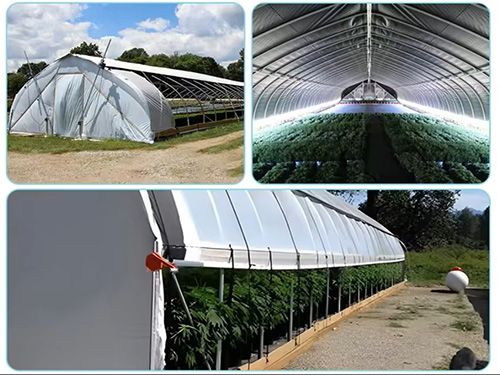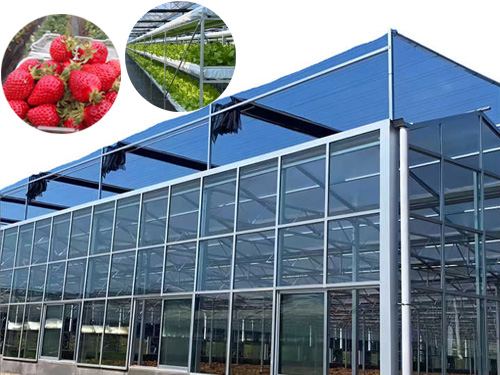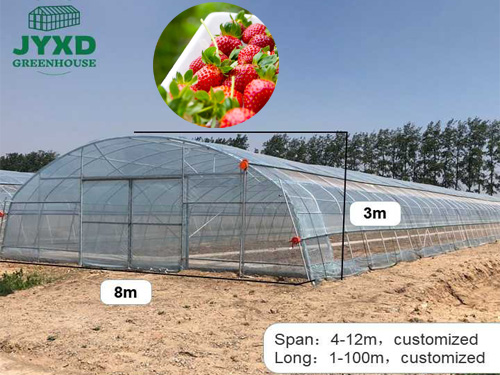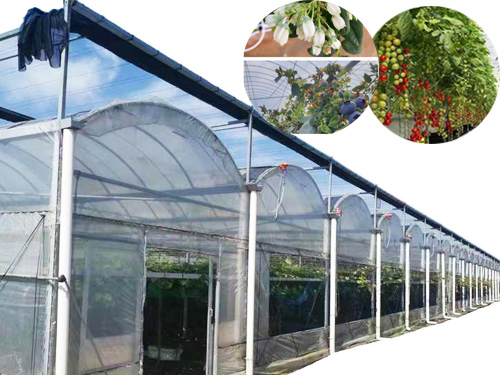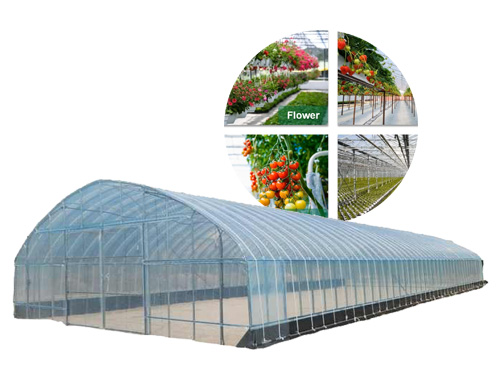NEWS DETAILS
NEWS INFORMATION
How Opaque Greenhouse Film Helps Maintain Ideal Growing Conditions: Benefits for Temperature Control and Light Diffusion
AUTHOR:jyxd-greenhouse DATE:2025-01-30 05:47:47 HITS:115
Greenhouses provide controlled environments that support year-round crop production. However, maintaining optimal growing conditions—particularly with respect to temperature and light—is crucial for maximizing plant health and yield. One of the key technologies that help regulate these factors is opaque greenhouse film. This specialized material not only plays a vital role in controlling light diffusion and temperature, but it also offers several other benefits that contribute to the success of greenhouse farming. In this article, we will explore how opaque greenhouse film works and its advantages for temperature control, light diffusion, and overall greenhouse efficiency.
Understanding Opaque Greenhouse Film
Opaque greenhouse films are specially designed coverings that allow light to penetrate the structure while diffusing it evenly throughout the space. Unlike transparent or clear films, opaque films limit direct sunlight exposure and scatter light in various directions, preventing excessive heat buildup and ensuring uniform illumination across the greenhouse.
The main function of opaque greenhouse films is to regulate both light and temperature. These films are typically made from materials like polyethylene and come in various thicknesses and types, depending on the specific needs of the greenhouse.
Temperature Control: Maintaining a Stable Environment
Temperature control is one of the most critical aspects of greenhouse management. Greenhouse crops need a consistent and stable temperature range to thrive. Too much heat can cause plant stress, while too little heat can slow down growth. Opaque greenhouse films offer a reliable solution to regulating temperature by reducing excessive heat accumulation and enhancing thermal stability.
1. Reducing Heat Build-Up
Opaque greenhouse films help to block out some of the sun's intense heat, preventing rapid temperature spikes inside the greenhouse. During the daytime, direct sunlight can cause the temperature inside a greenhouse to rise quickly, especially during the summer months. The opaque film scatters sunlight, diffusing it evenly and limiting the intensity of direct radiation. This helps to prevent overheating, which can harm plants and lead to higher cooling costs.
· Cooling Efficiency: By controlling the amount of solar heat entering the greenhouse, opaque films reduce the workload of cooling systems such as fans or evaporative cooling systems. This leads to less energy consumption and more stable growing conditions.
· Preventing Overheating: During hot weather, opaque films create a shaded effect, reducing the need for mechanical cooling and minimizing the risk of temperature extremes.
2. Improving Heat Retention at Night
Opaque greenhouse films are also beneficial in maintaining temperatures during cooler nighttime hours. After the sun sets, temperatures inside the greenhouse can drop rapidly, potentially stressing plants. The diffused light properties of opaque films help to retain heat inside the greenhouse, slowing down heat loss and maintaining a more consistent nighttime temperature.
· Thermal Insulation: Many opaque films are designed with insulating properties that prevent heat from escaping, thus keeping the internal environment more stable. This is particularly important in regions with significant day-to-night temperature fluctuations.
· Extended Growing Seasons: By improving nighttime heat retention, opaque films can help extend the growing season in cooler climates, providing crops with more favorable conditions for growth year-round.
Light Diffusion: Enhancing Photosynthesis and Plant Growth
Light is one of the most critical factors affecting plant growth. Insufficient or uneven light distribution can lead to poor photosynthesis and suboptimal crop yields. Opaque greenhouse films help to address these issues by diffusing light evenly throughout the greenhouse space.
1. Even Light Distribution
One of the primary benefits of opaque greenhouse film is its ability to diffuse sunlight across the entire greenhouse. Unlike clear films, which may allow sunlight to be concentrated in specific areas, opaque films scatter light, ensuring that all plants receive a more even and consistent level of illumination. This helps to avoid shading, which can occur when certain parts of the greenhouse receive too much sunlight while others receive too little.
· Uniform Growth: Even light distribution promotes uniform plant growth, as all crops receive the necessary light for photosynthesis, regardless of their position in the greenhouse.
· Optimized Photosynthesis: With a more consistent light intensity, plants can perform photosynthesis more effectively, leading to healthier growth and better yields.
2. Reducing Plant Stress from Direct Sunlight
In some climates, especially those with intense sunlight, direct sunlight can cause stress to plants. High light intensity can lead to leaf burn, dehydration, and reduced crop quality. Opaque films help to diffuse and soften the light, reducing the intensity of direct sunlight and preventing plant stress.
· Protection from UV Rays: Some opaque greenhouse films are treated to block harmful UV rays, which can damage plant tissues and reduce the overall health of crops. This added protection ensures that plants are not exposed to harmful radiation while still receiving the beneficial light they need.
· Improved Flowering and Fruiting: With more evenly distributed and gentler light, plants can focus their energy on growth, flowering, and fruiting, rather than on recovering from light stress.
3. Promoting Uniform Temperature-Light Interactions
Temperature and light are closely linked in a greenhouse environment. The interplay between light levels and temperature can significantly impact plant development. Opaque greenhouse films help create a balanced environment where light and temperature are optimized for plant growth.
· Thermo-Optical Effects: Opaque films with thermally efficient properties balance the effects of sunlight and temperature. By diffusing light and regulating the amount of heat entering the greenhouse, these films help to avoid temperature extremes caused by excessive sunlight.
· Preventing Leaf Burn and Overheating: With a better-controlled light environment, the risk of plants experiencing leaf burn due to intense direct sunlight is reduced, leading to healthier crops.
Additional Benefits of Opaque Greenhouse Film
In addition to temperature control and light diffusion, opaque greenhouse films offer several other advantages that enhance greenhouse operations.
1. Energy Efficiency
By improving temperature regulation and reducing the need for additional cooling or heating, opaque greenhouse films help to lower overall energy consumption. This can result in significant savings on energy costs, which is especially important for large-scale greenhouse operations.
2. Extended Crop Lifespan
The stable environment created by opaque films, with consistent temperature and light, can contribute to a longer growing season for crops. In turn, this allows farmers to produce more crops annually and improve overall profitability.
3. Increased Pest and Disease Control
The reduced intensity of direct sunlight can also help to create an environment that is less conducive to pest and disease outbreaks. Excessive sunlight can dry out plants and create conditions that attract certain pests, but with opaque films, the balance of temperature and light helps to deter such issues.
Conclusion
Opaque greenhouse film is a highly effective tool for maintaining ideal growing conditions within a greenhouse. By controlling temperature fluctuations, reducing heat build-up, and ensuring even light distribution, opaque films contribute to a stable and productive growing environment. These benefits, combined with energy efficiency and improved plant health, make opaque greenhouse films an excellent investment for greenhouse operators looking to enhance crop yields and optimize resource use. With the right type of opaque film, greenhouse growers can create a more sustainable and cost-effective environment that supports healthy and robust plant growth year-round.
Hebei Juyou Xinda Greenhouse Facilities Co.,Ltd.
Copyright © 2024-2025 https://www.jyxd-greenhouse.com. All Rights Reserved Hebei Juyou Xinda Greenhouse Facilities Co.,Ltd.Copyright





 Current Location:
Current Location:


